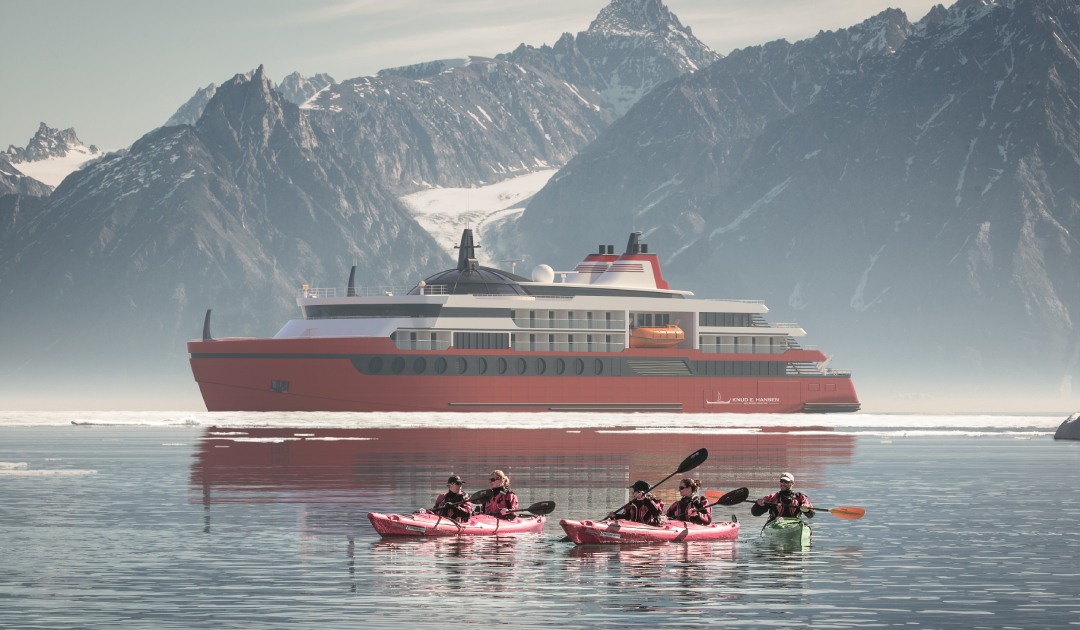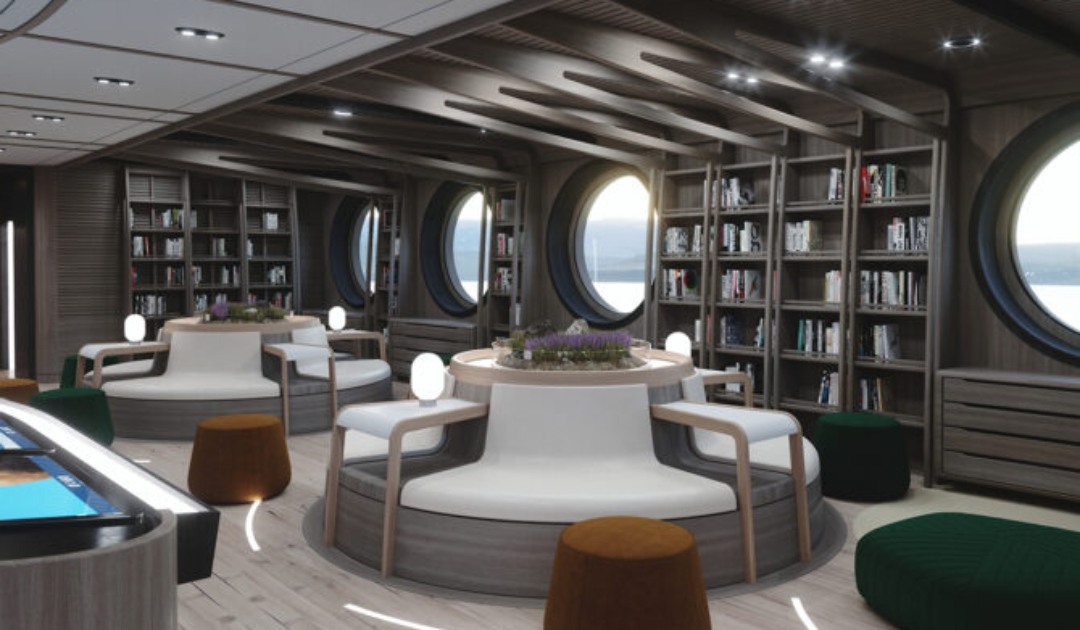
The Arctic Ocean is opening up, and the company KNUD E. HANSEN is busy designing the vessels that will sail it. Cruise ships with shops for remote communities and engine rooms ready for fewer carbon emissions are among their features.
In remote Arctic settlements, even the most essential goods and services can be hard to come by. In villages of less than 500 people, grocery options are few, schools have limited room, and health care services are all but non-existent.
At the same time, during summer months, well-supplied cruise ships with at least as many people often pass by these remote communities.
These two facts were essential to the Greenlandic owner in one of the latest designs from the ship design company KNUD E. HANSEN.
The 100Pax Greenland Explorer aims to make interactions between cruise ships and local communities mutually beneficial. The ship is designed so that the inhabitants can come aboard to stock up on essentials, have blood tests taken by a nurse, and use onboard science-facilities as part of school programs.
“This ship aims to make the meeting between tourists and locals more of an equal encounter. It could help support remote communities which can be a huge challenge in Greenland,” Rasmus Nygaard, Business Development MSSc. at KNUD E. HANSEN told Polar Journal.




Less ice, more ice sailing
The 100Pax Greenland Explorer is far from the only Polar ship that KNUD E. HANSEN have designed. Each year, the company develop around 30 new designs for customers around the world, out of which around a handful would have the capability to sail in polar waters.
Not all designs turn into reality but among the ones that have are the state-of-the-art Australian research icebreaker RSV Nuyina, the Danish research vessel Dana V, and two mega-roll-on/roll-off icebreaking cargo ships for Wallenius SOL and Finnlines.
KNUD E. HANSEN does count the design of polar vessels as one of its core competencies, and a business that will only expand in the future. Because, as conditions of polar sea ice is changing, new waters like the Arctic Ocean are suddenly becoming accessible.
“We might see a whole new ocean opening up. But this does not mean that it will be an ice-free ocean. Instead, it means that there will be a lot of activity in waters that are full of ice,” Rasmus Nygaard said.
“Over the next 50 years, icebreaking and ice-bumbing will become a capability that many ship types will need since, in the far north, we will simply be sailing in more ice,” he said.


Icebreaking as a capability
Traditionally, icebreakers have often been seen as special-purpose ships whose sole reason to exist were to break their way through icy waters so other ships could follow their lane. But in the future, according to Rasmus Nygaard, that view will be outdated.
“For us, icebreakers are not just icebreakers. Icebreaking is a capability of a ship that will sail Polar waters. It could be anything from fishing boats to roll-on/roll-off ferries, research vessels and cruise ships,” he said.
As a case in point, he mentions the cruise ship Ocean Explorer which ran aground in East Greenland last year. The situation itself was not dangerous; the problem was that the nearest ship was days of travel away.
“It showed that as more and more cruise ships are lured to the Arctic by the ice-free waters, they need to be designed for the remote conditions,” he said.
So, when designing ships, KNUD E. HANSEN follow the Polar Code and the Polar Class for icebreaking capabilities as implemented in 2007. The Polar Classes spans seven different levels and allows ships to be designed specifically for the ice conditions they are likely to face.
The 100Pax Greenland Explorer from above, for instance, has a classification of PC6 which makes it suitable for “summer and autumn operation in medium first-year ice which may include old ice inclusions”, a suitable classification for cruise ship operations in West Greenland.
“It is no longer just about classical icebreaking; it is about designing for different types of ice. There are many different types of ice conditions; thin ice or thick ice, first year ice or second year ice, multiple year ice, glacier ice, ridges, brash ice, and so on. It is not a given that there will only be one type of ice,” he said.

Future fuels less feasible in the Arctic
Another important aspect of the polar ships of the future will be their ability to emit less CO2 into the atmosphere and thus diminish the global warming that is expanding their area of operations.
Most of the global shipping industry is currently wrestling with ways to achieve this goal. In the immediate future, methanol or ammonia-based “green” fuel are solutions that many shipping companies are moving towards. But in the Polar regions, for logistical reasons, these types of fuel will be difficult to implement, Rasmus Nygaard explained.
“First of all, the new alternative fuels are really hard to get,” he said.
“And secondly, if you are going to deliver methanol to the Arctic, you need to have a working business. You can’t just put up a tank of methanol in Sisimiut and expect it to be sold. There simply won’t be enough ships in the years ahead,” he said.
“These new business models for providers of alternative fuels will only work in areas where many ships pass by, and it will take a long time before it will be feasible to sell methanol in Greenland, for instance,” he said.
Nevertheless, when designing Polar ships, KNUD E. HANSEN takes the possibility of new developments in fuel into account. As a rule of thumb, the lifetime of a ship is around 30 years, but as they cannot predict which fuel type will prevail in 15, they design the next generation of vessels with flexibility.
“In some ships, for instance, we place the generators high up in the ship. This makes it easier to replace them than if they had been embedded deep in the hull of the ship. We try to design the new ships in ways that make it easy to convert them in the future,” he said.




NATO needs more icebreakers
It is not only cruise ships for tourists that will benefit from the opening up of the Arctic Ocean. More geopolitically important players are also watching developments in icebreaking ships, Rasmus Nygaard warned.
“The Russians have built themselves some big Arctic capabilities, and they are also creating a sea route through the Arctic Ocean with icebreaking container ships. Our point is that NATO has fallen far behind in terms of having icebreaking capabilities like the Russians; not just in terms of frigates and patrol ships but also in terms of ‘semi-grey’ vessels, support vessels and cargo ships,” he said.
To stress this point, he mentioned that currently, while Russia has built up a fleet of several icebreakers, the most capable icebreaking vessel under a NATO flag is the French cruise ship Le Commandant Charcot.
“NATO, too, needs more ships for carrying military equipment, also in the Arctic. Not least because the Arctic Ocean will become more and more accessible in the coming years,” Rasmus Nygaard said.
Ole Ellekrog, Polar Journal AG
More on the topic:





